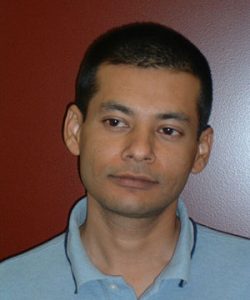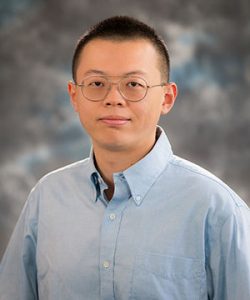The University of Florida Department of Computer & Information Science & Engineering offers a wide range of research areas. Below, you will find a majority of the areas studied in the department and the respective faculty who are working in these areas.
Click each of the research areas below to view the associated faculty.


Primary Research Area
Machine Learning
Research Areas
Machine Learning
Education
Ph.D., Computer Engineering, University of Florida, 2017
M.S., Computer Engineering, University of Florida, 1999
B.A., Classical Studies, University of Florida, 1997
Research Interests
Machine Learning, Natural Language Processing, Object-Oriented Programming

Bonnie J. Dorr is a Professor of Computer Science at the University of Florida and a member of the Florida Institute for National Security (FINS). She leads the Natural Language Processing (NLP) Research Laboratory, where her work centers on artificial intelligence methods for deep language understanding, multilingual processing, and explainable AI.



Dr. Graim received her Ph.D. in 2016 from the University of California, Santa Cruz, advised by Professor Josh Stuart. She did postdoctoral research at Princeton University and the Flatiron Institute, Simons Foundation, working with Professor Olga Troyanskaya. Dr. Graim’s research operates at the confluence of life science research and computer science. Her lab develops machine learning models that integrate diverse large-scale genomics data to address key questions in human health and disease.…

Dr. Christan Grant is an Arnold and Lisa Goldberg Rising Star Associate Professor in Computer Science at the University of Florida Department of Computer & Information Science & Engineering. Dr. Grant leads the UF Data Studio. In this role, he conducts research on various aspects of the data pipeline, including data acquisition, labeling, interactive machine learning, and visualization.…

Primary Research Area: Artificial Intelligence and Machine Learning
Research Areas:
- Artificial Intelligence
- Machine Learning
- Formal Methods and Logic
- Emerging Computing Paradigms
Research Interests:
- Interpretability of Artificial Intelligence
- Control of Artificial Intelligence Systems
- Robust and Efficient Artificial Intelligence
- Emerging Computing Paradigms
- Cybersecurity and Artificial Intelligence
- Formal Methods and Logic
Publications:
An updated list of my selected publications is available at: https://sumitkumarjha.com/publications

Dr. Jiang is an assistant professor in CISE at the University of Florida. He received his Ph.D. in computer science from the University of Minnesota and his B.E. from the University of Science and Technology of China (USTC). His lab’s mission is to design and develop accurate, scalable, and robust AI and machine learning algorithms and tools inspired by interdisciplinary applications (Earth sciences, agriculture, smart cities, biomedicine, public health).…

Tamer Kahveci received his Ph.D. degree in Computer Science from the University of California at Santa Barbara in 2004. He is currently a Professor and Associate Chair of Academic Affairs in the Computer and Information Science and Engineering Department at the University of Florida, serving as the Associate Chair of Academic Affairs. Dr. Kahveci received the Ralph E.…

Dr. Yuanyuan Lei is an Assistant Professor of Computer Science at the University of Florida. Her research direction is Natural Language Processing (NLP), Large Language Models (LLMs), Machine Learning, Artificial Intelligence. Her research vision is to develop innovative algorithms and systems for knowledge-aware language modeling, enriching LLMs with diverse forms of knowledge to advance reasoning and planning capabilities of LLMs, as well as ensure trustworthiness and safety alignment of LLMs.…



Primary Research Area
Discrete and Computational Geometry
Research Areas
Discrete and Computational Geometry, Complexity, Algorithmic Foundations, Open source Mathematical Software, Foundations of Machine Learning, Modeling in Physics, Engineering and Game Theory
Education
Ph.D., University of Wisconsin-Madison
B.Tech, Indian Institute of Technology, Madras, India
Research Interests
Geometry, Complexity, Discrete modeling and algorithms, Open source mathematical software, Application of the above in Natural and Social Sciences and Engineering
Awards & Distinctions
- Fulbright-Nehru Academic and Professional Excellence Award: 2025-27(flex)
- Institute for Computational and Experimental Research in Mathematics (ICERM) fellow: Spring 2025
- Fields Institute Visiting Fellow: Summer 2023 and Spring 2021
- UF Term Professorship 2018-21
- Alexander von Humboldt Fellow 1990-92

Primary Research Area: Artificial Intelligence and Machine Learning Systems
Research Areas: Edge AI Systems, Efficient AI, Trustworthy AI
Research Interests: Efficient Edge AI Systems, Collaborative Intelligence Systems, Reliable AI, and Personalized AI.
Publications: Publications can be found on my website or Google Scholar. Websites: Home page
Awards & Distinctions: Best Paper Award of the AAAI Spring Series Symposium 2024 in Federated Learning on the Edge


Primary Research Area: Formal Methods, AI Safety, Cyber-Physical Systems, Robotics
Research Areas: Verification and Validation for Learning-enabled Autonomy
Research Interests: Formal Verification, Specification and Modeling Languages, AI Safety
Publications: See my Google Scholar: https://scholar.google.com/citations?user=_RzS3uMAAAAJ&hl=en
Websites: (links to personal and professional websites): https://sites.google.com/view/v2a2/about
Awards & Distinctions:
- NSF CAREER (2025)
- SIU PRIZE Golden Medal (2025) for Young Vietnamese Scientist in Computer Science Worldwide
- NSF EPSCoR Early Career First Award, 2022
- IEEE TCCPS Outstanding PhD Dissertation Award (2021)



Eakta Jain, Ph.D., is an associate professor in the Department of Computer & Information Science & Engineering at the University of Florida. She received her Ph.D. and M.S. degrees in Robotics from Carnegie Mellon University and her B.Tech. degree from IIT Kanpur. She has industry experience at Texas Instruments R&D labs, Disney Research Pittsburgh, and the Walt Disney Animation Studios.…


Primary Research Area
Discrete and Computational Geometry
Research Areas
Discrete and Computational Geometry, Complexity, Algorithmic Foundations, Open source Mathematical Software, Foundations of Machine Learning, Modeling in Physics, Engineering and Game Theory
Education
Ph.D., University of Wisconsin-Madison
B.Tech, Indian Institute of Technology, Madras, India
Research Interests
Geometry, Complexity, Discrete modeling and algorithms, Open source mathematical software, Application of the above in Natural and Social Sciences and Engineering
Awards & Distinctions
- Fulbright-Nehru Academic and Professional Excellence Award: 2025-27(flex)
- Institute for Computational and Experimental Research in Mathematics (ICERM) fellow: Spring 2025
- Fields Institute Visiting Fellow: Summer 2023 and Spring 2021
- UF Term Professorship 2018-21
- Alexander von Humboldt Fellow 1990-92


Alper Üngör’s research is on the junction of the two main branches of computer science, theoretical computer science and scientific computing. Specifically, his research interests are in computational geometry, with special emphasis in mesh generation. His main goal is to understand the mathematical (mostly geometrical) structure of engineering problems and develop provably good algorithms to solve them.…


Dr. Graim received her Ph.D. in 2016 from the University of California, Santa Cruz, advised by Professor Josh Stuart. She did postdoctoral research at Princeton University and the Flatiron Institute, Simons Foundation, working with Professor Olga Troyanskaya. Dr. Graim’s research operates at the confluence of life science research and computer science. Her lab develops machine learning models that integrate diverse large-scale genomics data to address key questions in human health and disease.…

Tamer Kahveci received his Ph.D. degree in Computer Science from the University of California at Santa Barbara in 2004. He is currently a Professor and Associate Chair of Academic Affairs in the Computer and Information Science and Engineering Department at the University of Florida, serving as the Associate Chair of Academic Affairs. Dr. Kahveci received the Ralph E.…

Primary Research Area
Discrete and Computational Geometry
Research Areas
Discrete and Computational Geometry, Complexity, Algorithmic Foundations, Open source Mathematical Software, Foundations of Machine Learning, Modeling in Physics, Engineering and Game Theory
Education
Ph.D., University of Wisconsin-Madison
B.Tech, Indian Institute of Technology, Madras, India
Research Interests
Geometry, Complexity, Discrete modeling and algorithms, Open source mathematical software, Application of the above in Natural and Social Sciences and Engineering
Awards & Distinctions
- Fulbright-Nehru Academic and Professional Excellence Award: 2025-27(flex)
- Institute for Computational and Experimental Research in Mathematics (ICERM) fellow: Spring 2025
- Fields Institute Visiting Fellow: Summer 2023 and Spring 2021
- UF Term Professorship 2018-21
- Alexander von Humboldt Fellow 1990-92

Dr. Christan Grant is an Arnold and Lisa Goldberg Rising Star Associate Professor in Computer Science at the University of Florida Department of Computer & Information Science & Engineering. Dr. Grant leads the UF Data Studio. In this role, he conducts research on various aspects of the data pipeline, including data acquisition, labeling, interactive machine learning, and visualization.…



Primary Research Area
Discrete and Computational Geometry
Research Areas
Discrete and Computational Geometry, Complexity, Algorithmic Foundations, Open source Mathematical Software, Foundations of Machine Learning, Modeling in Physics, Engineering and Game Theory
Education
Ph.D., University of Wisconsin-Madison
B.Tech, Indian Institute of Technology, Madras, India
Research Interests
Geometry, Complexity, Discrete modeling and algorithms, Open source mathematical software, Application of the above in Natural and Social Sciences and Engineering
Awards & Distinctions
- Fulbright-Nehru Academic and Professional Excellence Award: 2025-27(flex)
- Institute for Computational and Experimental Research in Mathematics (ICERM) fellow: Spring 2025
- Fields Institute Visiting Fellow: Summer 2023 and Spring 2021
- UF Term Professorship 2018-21
- Alexander von Humboldt Fellow 1990-92

Alper Üngör’s research is on the junction of the two main branches of computer science, theoretical computer science and scientific computing. Specifically, his research interests are in computational geometry, with special emphasis in mesh generation. His main goal is to understand the mathematical (mostly geometrical) structure of engineering problems and develop provably good algorithms to solve them.…



My research interests span: Statistics on Manifolds, Medical Image Computing, Computer Vision and Graphics, Statistical Learning, Information Geometry and Applied Mathematics. Most of my research these days is concerned with efficient recursive computation of statistics on Riemannian manifolds with applications to atlas (reference template) construction, clustering, data retrieval in Medical Imaging and Computer VIsion and Machine Learning.…






Dr. Graim received her Ph.D. in 2016 from the University of California, Santa Cruz, advised by Professor Josh Stuart. She did postdoctoral research at Princeton University and the Flatiron Institute, Simons Foundation, working with Professor Olga Troyanskaya. Dr. Graim’s research operates at the confluence of life science research and computer science. Her lab develops machine learning models that integrate diverse large-scale genomics data to address key questions in human health and disease.…

Dr. Christan Grant is an Arnold and Lisa Goldberg Rising Star Associate Professor in Computer Science at the University of Florida Department of Computer & Information Science & Engineering. Dr. Grant leads the UF Data Studio. In this role, he conducts research on various aspects of the data pipeline, including data acquisition, labeling, interactive machine learning, and visualization.…

Dr. Jiang is an assistant professor in CISE at the University of Florida. He received his Ph.D. in computer science from the University of Minnesota and his B.E. from the University of Science and Technology of China (USTC). His lab’s mission is to design and develop accurate, scalable, and robust AI and machine learning algorithms and tools inspired by interdisciplinary applications (Earth sciences, agriculture, smart cities, biomedicine, public health).…

Tamer Kahveci received his Ph.D. degree in Computer Science from the University of California at Santa Barbara in 2004. He is currently a Professor and Associate Chair of Academic Affairs in the Computer and Information Science and Engineering Department at the University of Florida, serving as the Associate Chair of Academic Affairs. Dr. Kahveci received the Ralph E.…

I lead the Indie (Interactive Data and Immersive Environments) research lab. The Indie Lab conducts research in areas including human-computer interaction (HCI), human-centered computing (HCC), information visualization, virtual reality, 3D interaction, and visual analytics. Previously, I was an assistant professor at Texas A&M University with the Department of Visualization and the Department of Computer Science & Engineering.…


My research interest is to build systems and design algorithms to support large-scale and advanced data analysis (e.g., using statistics and machine learning), which goes beyond simple aggregations and OLAP in traditional databases and data warehouses.
I am the director of the UF Data Science Research lab. The current focus of the lab is on building and reasoning wth probabilistic knowledge graphs from text, images and crowd.


Eakta Jain, Ph.D., is an associate professor in the Department of Computer & Information Science & Engineering at the University of Florida. She received her Ph.D. and M.S. degrees in Robotics from Carnegie Mellon University and her B.Tech. degree from IIT Kanpur. She has industry experience at Texas Instruments R&D labs, Disney Research Pittsburgh, and the Walt Disney Animation Studios.…


I lead the Indie (Interactive Data and Immersive Environments) research lab. The Indie Lab conducts research in areas including human-computer interaction (HCI), human-centered computing (HCC), information visualization, virtual reality, 3D interaction, and visual analytics. Previously, I was an assistant professor at Texas A&M University with the Department of Visualization and the Department of Computer Science & Engineering.…


Jeremiah Blanchard’s research focuses on computer science education and research in human-computer interaction in education. This work includes examination of programming language representations and exploration of how educational games can help students learn science, technology, engineering, and mathematics. He holds a Ph.D. in Computer Engineering from the University of Florida.
Previously, Dr. Blanchard served as Program Director over Game Development at Full Sail University in Winter Park, Florida (in the greater Orlando area), where he taught, served in administration, and developed educational and health-related games.…

Dr. Sharon Lynn Chu is part of the Human-Centered Computing group and directs the Embodied Learning & Experience (ELX) Lab. The ELX Lab conducts research in human-computer interaction (HCI) focusing specifically on cyberlearning (technologies to support learning) and positive computing (technologies for health and well-being). The primary mission of the Lab is to conceptualize, investigate, design, and develop technology-based approaches to solve real individual and societal problems.…


Eakta Jain, Ph.D., is an associate professor in the Department of Computer & Information Science & Engineering at the University of Florida. She received her Ph.D. and M.S. degrees in Robotics from Carnegie Mellon University and her B.Tech. degree from IIT Kanpur. She has industry experience at Texas Instruments R&D labs, Disney Research Pittsburgh, and the Walt Disney Animation Studios.…

Amanpreet Kapoor is a lecturer in the Department of Engineering Education, and he teaches computing undergraduate courses in the Department of Computer & Information Science & Engineering (CISE). He received his M.S. in Computer Science from the University of Florida in 2016 and a B. Tech. in Computer Science & Engineering from Jaypee University of Engineering and Technology, India in 2015.…

Primary Research Area
Human-Centered Computing
Research Areas
Human-Centered Computing
Education
Ph.D., Computer Science and Engineering, University of Michigan – 2012
M.S., Computer Science and Engineering, University of Michigan – 2007
B.S., Computer Science, University of Maryland, Baltimore County – 2005
Research Interests
Utilizing signal processing to render 3D audio, Using 3D audio to sonify information and environments, Discovering interface design techniques for developing virtual auditory environments, Using 3D audio to augment assistive technology for persons with visual impairments, Enhancing immersion and realness in virtual worlds using 3D audio
Publications
See full list here.…


I lead the Indie (Interactive Data and Immersive Environments) research lab. The Indie Lab conducts research in areas including human-computer interaction (HCI), human-centered computing (HCC), information visualization, virtual reality, 3D interaction, and visual analytics. Previously, I was an assistant professor at Texas A&M University with the Department of Visualization and the Department of Computer Science & Engineering.…


Alexandre G. de Siqueira, Ph.D., is an Assistant Instructional Professor at the Department of Computer & Information Science & Engineering. His research focuses on human-centered computing and human-computer interaction. This work includes investigating the intersection between tangible user interfaces, multi-touch, augmented, and virtual reality and examining Virtual 3D Social Spaces for enhanced learning environments. He is also interested in the maker movement, and how rapid digital prototyping can be brought to the masses.…

Dr. Sanethia Thomas serves as a Senior Lecturer at the University of Florida. She earned her Ph.D. in Computer & Information Science & Engineering with a focus on Human Centered Computing, accompanied by a certificate in Athlete Development, also from the University of Florida. Dr. Thomas is a National Science Foundation Fellow and a GEM Fellow.…


My research interests span: Statistics on Manifolds, Medical Image Computing, Computer Vision and Graphics, Statistical Learning, Information Geometry and Applied Mathematics. Most of my research these days is concerned with efficient recursive computation of statistics on Riemannian manifolds with applications to atlas (reference template) construction, clustering, data retrieval in Medical Imaging and Computer VIsion and Machine Learning.…







No results.













